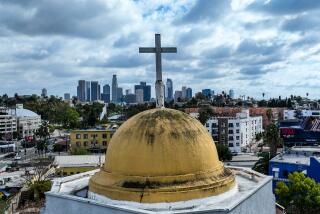Sunday Briefing : On a Mission
This year, volunteer architects, engineers and students from the University of Pennsylvania arrived at the venerable Mission San Juan Capistrano before the swallows. Their mission: stabilize the decaying Great Stone Church so it can be maintained as a ruin. The church was partially destroyed by an earthquake in 1812 and never rebuilt. The work is part of a $19.5-million project that would refurbish various parts of the entire mission property. A look at the church, the mission, it’s present and past:
What They’ll Fix
Working with local engineers, architecture students from the University of Pennsylvania will stabilize the east wall of the church to determine the amount of time, material and money needed to prevent further decay of the structure. Major problems facing the Great Stone Church:
Mortar
Problem: Walls unstable from eroding mortar and loosened stones; head-size stones fall from walls
Solution: Remove old grout, replace with stronger new mix; replace fallen stones
*
Plaster
Problem: Plaster peels, falls off wall
Solution: Develop adhesive to re-adhere fallen plaster and a method to inject adhesive behind lifting plaster
*
Pillars
Problem: Decorative detail on pillars wearing away
Solution: Spray on shellac to protect pillars from rain and prevent crumbling
*
Projected Costs
Other sections of the mission need work as well. The project will be subsidized by donations and admissions. A look at how an estimated $19.5 million in costs will be divided:
* Great Stone Church (In progress)
Illuminate church, build education center to depict church before 1812 and preserve structure
Cost: $7 million
*
* Soldiers’ barracks
Stabilize for earthquakes and preserve adobe walls
Cost: $505,000
*
* Front Gatehouse
Enlarge to include space for large groups, restrooms and gift shop
Cost: $1.4 million
*
* Front Wall
Restore adobe walls at mission front and replace wire fence with period-type block wall
Cost: $562,000
*
* Living History (In progress)
Exhibit customs, furniture, costumes of colonial rancho
Cost: $15,000
*
* Museum Renovation
Update exhibits
Cost: $20,000
*
* Permanent Endowment
Fund mission maintenance and perpetuation costs
Cost: $10 million
*
The Great Quake: On Dec. 8, 1812, an earthquake shook the church during a service. The roof caved in, the adobe walls collapsed and the bells tumbled from the tower. Thirty-eight people were killed.
*
Bells: The four bells in the Scared Garden once hung in the bell tower of the Great Stone Church.
Mission Construction: The original mission ceilings were made of reeds from local creeks and adobe, with timber beams.
The Great Stone Church
Capistrano’s chruch took nine years to build. Construction was supervised by Isidro Aguilar, a master stone mason, using Indian labor. Dedicated in 1806, it stood for only six years.
Blue line represents what remains of the original church
Signature dome: The dome over the sanctuary survived the earthquake, but collapsed later during an attemped restoration.
Bell tower: The massive, 120-foot tower could be seen for 10 miles. It had four bells, cast in 1796 and 1804, that were used to call the community to meals, work and religious services.
Stone: The yellow sandstone used was carried by laborers from a quarry six miles northeast of the mission.
Design: Built in the form of a cross, 180 feet long and 40 feet wide, with a vaulted ceiling topped by seven domes.
Site Selection
Mission San Juan Capistrano was built at the juncture of Trabuco and San Juan creeks, which provided plenty of drinking water and irrigation.
Other reasons:
* Site in a fertile valley of coastal mountains
* Close to natural harbor good for trading mission products
* Nearby Juaneno Indians to provide mission laborers
Life at the Mission
During the Day: Work within the mission was centered around self-sufficiency and prayer. Workers tanned hides, made candles and soap, ground grain and crushed olives and grapes. They also raised cattle, wheat and barley. Days began at dawn when priests rang bells to call the village to worship.
Tribal Changes: Missionaries called local Indians Juanenos, for San Juan Capistrano. Their main staple was acorns, sometimes ground into meal or flour. They also hunted deer and fished with nets. After the missionaries arrived, Juanenos planted crops, including grapes and wheat. Homes were made of reeds, palm fronds and sticks; the Spaniards taught them to make clay tiles and adobe buildings.
The Coastal Churches
California’s missions are an extension of those dotting the Baja California desert. Missionaries traveled from Baja to San Francisco along a trail known as El Camino Real (royal highway)--today, Interstate 5. California missions and when they were established:
San Diego de Alcala, 1769
San Carlos Borromeo de Carmelo, 1770
San Antonio de Padua, 1771
San Gabriel Arcangel, 1771
San Luis Obispo de Tolosa, 1772
San Francisco de Asis, 1776
San Juan Capistrano, 1776
Santa Clara de Asis, 1777
San Buenaventura, 1782
Santa Barbara, 1786
La Purisima Concepcion, 1787
Santa Cruz, 1791
Nuestra Senora de la Soledad, 1791
San Jose, 1797
San Juan Bautista, 1797
San Miguel Arcangel, 1797
San Fernando Rey de Espana, 1797
San Luis Rey de Francia, 1798
Santa Inez, 1804
San Rafael Arcangel, 1817
San Francisco Solano, 1823
*
Father Junipero Serra
* Born Nov. 24, 1713, in Petra, on the Spanish island of Majorca
* Arrives in New World at 36
* Serves as priest for 54 years, traveling and establishing California missions
* Dies in Carmel in 1784
Mission’s Dates
1775: Father Lasuen dedicates San Juan Capistrano site, begins building temporary church. Work stops when word arrives that Indians have attacked Mission San Diego. Bells buried and padres return to San Diego.
1776: Father Serra arrives in San Juan; bells dug up and site moved south to confluence of San Juan and Trabuco creeks.
1777: First adobe church, Serra Chapel, erected.
1791: Bell tower built.
1796-1806: Great Stone Church construction.
1810: Mexican War of Independence begins.
1812: Earthquake collapses ceiling, crumbles bell tower. Bells are saved; services continue, in Serra Chapel.
1813: First swallows arrive at mission.
1821: Mexico wins independence from Spain.
1841: Capistrano becomes Mexican possession.
1845: Gov. Pio Pico sells mission to brother-in-law, Don Juan Forster, for $710. Forster family lives there.
1865: Abraham Lincoln returns mission to Catholic Church. Attempts to restore the mission actually damages the walls.
1895: Restoration of Serra Chapel begins.
1910: Father O’Sullivan leads Serra Chapel restoration, several adobe structures stabilized, gardens and fountains restored.
1924: Services resume in Serra Chapel.
1933: Mission restoration completed.
1978: Archeological studies of mission begin.
1991: Adobe structures undergo earthquake stabilization and preservation.
1996: Students and mission officials begin assessing cost of preventing further deterioration of the Great Stone Church.
Sources: Mission San Juan Capistrano; “California’s Spanish Missions,” by Spenser Crump; “Time of the Bells,” by Richard F. Pourade; World Book Encyclopedia
Researched by APRIL JACKSON and DENNIS LOWE / Los Angeles Times
More to Read
Sign up for Essential California
The most important California stories and recommendations in your inbox every morning.
You may occasionally receive promotional content from the Los Angeles Times.










